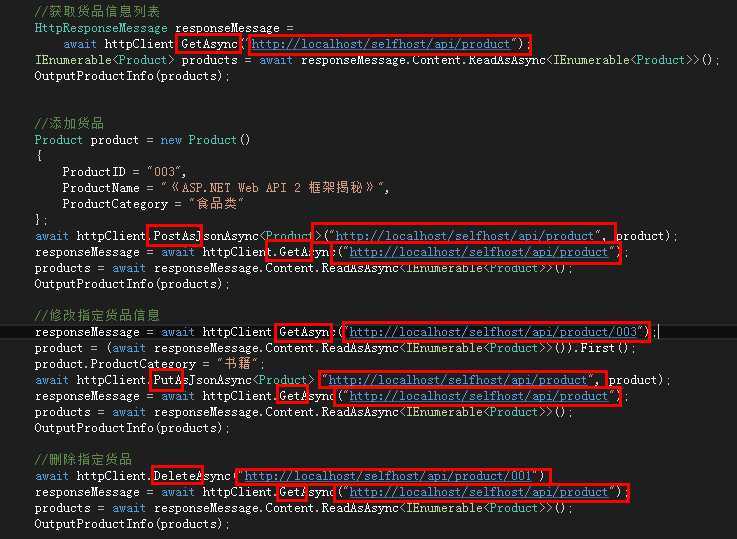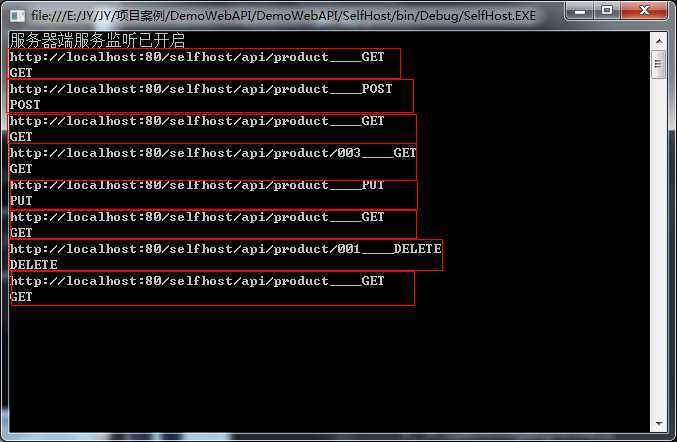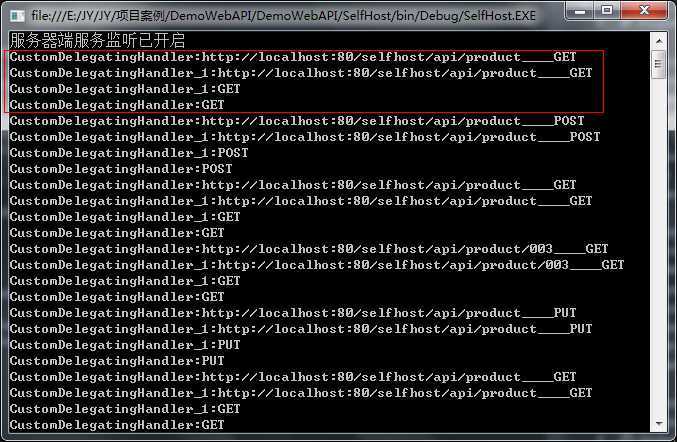ASP.NET Web API 管道模型
2020-12-13 05:57
标签:asp.net web api 管道模型 ASP.NET Web API是一个独立的框架,也有着自己的一套消息处理管道,不管是在WebHost宿主环境还是在SelfHost宿主环境请求和响应都是从消息管道经过的,这是必经之地,本篇就为大家简单的介绍一下ASP.NET Web API框架中的管道对象模型。 HttpMessageHandler消息处理程序(基类) 上面的代码中定义的是消息处理程序基类,在管道中的每一个消息处理部分都是继承自它。 并且定义了一个会执行异步操作的SendAsync()方法,这个方法也是串联管道中各个消息处理程序的一个入口,但是并不是靠它来串联。 DelegatingHandler消息处理程序(基类) 这里的DelegatingHandler继承自HttpMessageHandler类型,而且DelegatingHandler也是抽象类型,DelegatingHandler类型并不是就是简单的继承,而是对基类进行了扩展,使之变成一个带指向箭头(对象引用)的对象类型也就是InnerHandler属性,InnerHandler属性的值就是在当前这个消息处理程序的下一个消息处理程序,DelegatingHandler类型对基类的扩展,HttpMessageHandler类型我感觉它的存在就是一个规范,从管道中的第一个处理程序开始一直到最后一个,除了最后一个消息处理程序,其他的都是DelegatingHandler类型的子类(当然也是HttpMessageHandler的子类),最后一个消息处理程序是直接继承自HttpMessageHandler类型,因为它是最后一个处理程序了不必要有指向下一个处理程序的属性,这种对职责的划分真的很优美,说不出好在哪就是觉得漂亮。 HttpServer消息处理程序(实现类-管道头) HttpServer类型继承自DelegatingHandler类型,是作为管道中第一个消息处理的,要说明的是重载的这些构造函数,如果只是采用默认的构造函数的话,HttpConfiguration类型的参数默认的就是实例化HttpConfiguration类型,而HttpMEssageHandler类型的参数默认的是实例化HttpRoutingDispatcher类型的消息处理器,并且是赋值到Dispatcher属性的,是作为管道中最后一个消息处理器的(真正的操作实际不是它,后面篇幅会有讲到)。 HttpRoutingDispatcher消息处理程序(实现类-管道尾) HttpRoutingDispatcher类型继承自HttpMessageHandler类型,上面也说到过它是作为在管道中最后一个消息处理器的,说是可以这么说,但是真正执行的却不是它,而是在执行重载的构造函数的时候会默认的生成HttpControllerDispatcher类型作为HttpMessageHandler类型的构造函数参数,这里就不对它进行过多的阐述了,后面的篇幅自然会说明的很详细。 下面我们来看一下ASP.NET Web API管道的大概示意图。 图1 (蓝色线条表示请求,红色线条表示响应) 这样的示意图说明的不是太清晰下面我们用《ASP.NET Web API 开篇介绍示例》中的SelfHost环境下的示例来演示一下,这样大家自然就会清楚这个流程了。 首先我们定义一个消息处理器类型命令为CustomDelegatingHandler,并且继承自DelegatingHandler类型。示例代码如下 代码1-1 随之我们在SelfHost环境下的服务端在注册路由之后注册刚才我们新建的消息处理程序对象,示例代码如下: 代码1-2 在注册完毕,并且服务器已经启动开启请求监听,客户端也随之发出请求之后,我们再来看一下客户端发出的请求以及类型,如下图。 图2 这个时候我们再来看一下服务端管道处理情况,如下图。 图3 每一个红框圈中的部分都表示着一个请求和响应的流程跟图2中的所有请求是对应的,可以从代码1-1中就可以看出输出的内容。 如果说这样的示例并不不明显,不能让人很清楚明白的了解管道的执行过程以及顺序,那我们定义两个处理程序,并且修改代码1-1,示例代码如下: 代码1-3 随之我们注册管理处理程序的地方也要新增一个消息处理程序,示例代码如下: 代码1-4 这个时候按照图2之前的那段说明操作,再看一下服务端的管道处理情况,请求还是那些个请求,看下示意图如下: 图4 (红框部分的代表就是跟上面所说的一样,一个请求一个响应管道所对应的处理情况) 最后再看一下图5结合图4,这样更好更容易理解。 图5 作者:金源 出处:http://blog.csdn.net/jinyuan0829 本文版权归作者和CSDN共有,欢迎转载,但未经作者同意必须保留此段声明,且在文章页面 ASP.NET Web API 管道模型,搜素材,soscw.com ASP.NET Web API 管道模型 标签:asp.net web api 管道模型 原文地址:http://blog.csdn.net/jinyuan0829/article/details/38379135ASP.NET Web API 管道模型
前言
ASP.NET Web API路由、管道
管道模型介绍
public abstract class HttpMessageHandler : IDisposable
{
protected HttpMessageHandler();
public void Dispose();
protected virtual void Dispose(bool disposing);
protected internal abstract Task
public abstract class DelegatingHandler : HttpMessageHandler
{
protected DelegatingHandler();
protected DelegatingHandler(HttpMessageHandler innerHandler);
public HttpMessageHandler InnerHandler { get; set; }
protected override void Dispose(bool disposing);
protected internal override Task
public class HttpServer : DelegatingHandler
{
public HttpServer();
public HttpServer(HttpConfiguration configuration);
public HttpServer(HttpMessageHandler dispatcher);
public HttpServer(HttpConfiguration configuration, HttpMessageHandler dispatcher);
public HttpConfiguration Configuration { get; }
public HttpMessageHandler Dispatcher { get; }
protected override void Dispose(bool disposing);
protected virtual void Initialize();
protected override Task
public class HttpRoutingDispatcher : HttpMessageHandler
{
// Fields
private readonly HttpConfiguration _configuration;
private readonly HttpMessageInvoker _defaultInvoker;
// Methods
public HttpRoutingDispatcher(HttpConfiguration configuration);
public HttpRoutingDispatcher(HttpConfiguration configuration, HttpMessageHandler defaultHandler);
private static void RemoveOptionalRoutingParameters(IDictionarystring, object> routeValueDictionary);
protected override Task

public class CustomDelegatingHandler : DelegatingHandler
{
protected override Task
static void Main(string[] args)
{
HttpSelfHostConfiguration selfHostConfiguration =
new HttpSelfHostConfiguration("http://localhost/selfhost");
using (HttpSelfHostServer selfHostServer = new HttpSelfHostServer(selfHostConfiguration))
{
selfHostServer.Configuration.Routes.MapHttpRoute(
"DefaultApi", "api/{controller}/{id}", new { id = RouteParameter.Optional });
RegistrationMessageHandler(selfHostServer.Configuration);
selfHostServer.OpenAsync();
Console.WriteLine("服务器端服务监听已开启");
Console.Read();
}
}
static void RegistrationMessageHandler(HttpConfiguration httpconfiguration)
{
httpconfiguration.MessageHandlers.Add(new HttpMessageHandlers.CustomDelegatingHandler());
}


public class CustomDelegatingHandler : DelegatingHandler
{
protected override Task
static void RegistrationMessageHandler(HttpConfiguration httpconfiguration)
{
httpconfiguration.MessageHandlers.Add(new HttpMessageHandlers.CustomDelegatingHandler());
httpconfiguration.MessageHandlers.Add(new HttpMessageHandlers.CustomDelegatingHandler_1());
}

